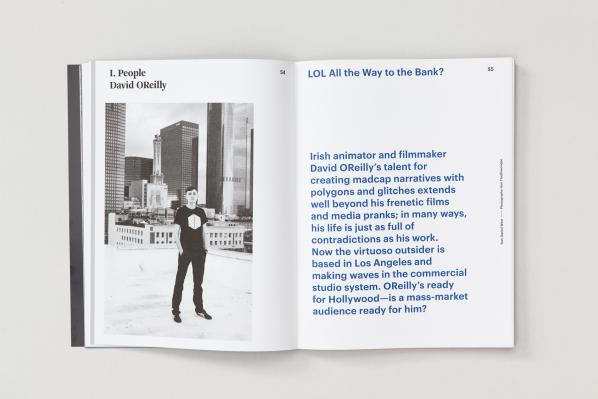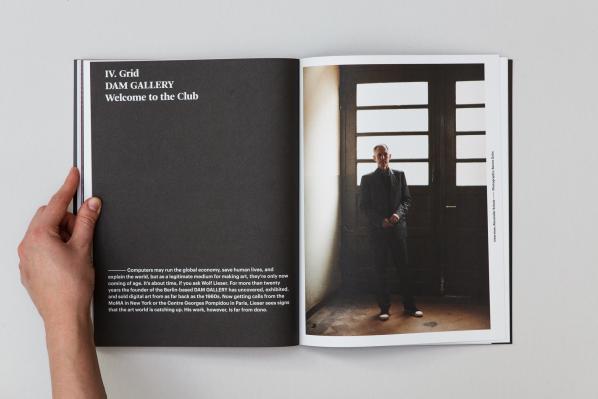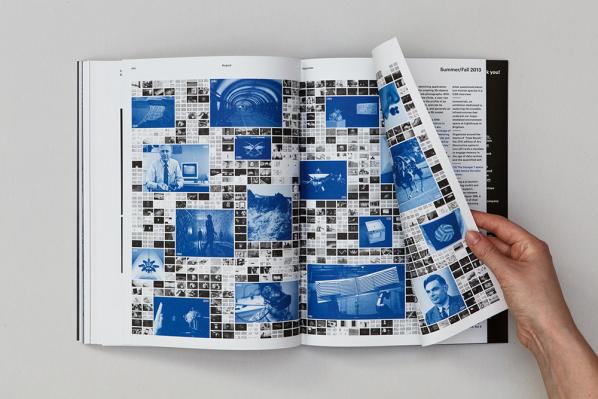



Featured image: HOLO magazine
You know a book review is going well when you disengage your critical mind and find yourself falling into the text and just soaking up everything you’re reading. HOLO magazine gets you like that. I don’t think it’s too much of an exaggeration to say that HOLO magazine is itself a work of art. And a solid, thick volume at that. In an era when many mainstream art magazines produce something that could easily fit into a satchel or handbag, HOLO sits on the table like a portable gallery space.
HOLO magazine’s first issue is curated into five sections: People (which appears twice – media arts people are just that interesting), Perspective, Grid and Frames, HOLO issue #1 tries to direct the reader into frameworks that set an agenda for consumption of the text. Which sounds like narrowing, but actually, it allows for a focussing of the attention. Not that the editors want to narrow the imaginative opportunities that the magazine might offer to readers – HOLO is a place for ideas. And even when it features interviews with people like David OReilly or Eno Henze, it still feels like a launching pad for upcoming artists to find inspiration and create their own work.

Coming across the David OReilly interview felt like finding something I’d already known, somewhere in the back of my mind, but it took HOLO to draw it out for me. OReilly’s quirky glitch-tastic work (particularly The External World) has been doing the rounds of film festivals for a while now, and I’m certain I’ve seen it at two in the UK. It’s no surprise to find that he has also created an episode of Adventure Time, the Cartoon Network series for kids that could well be the staple diet of insomniac adults with an eye on the bizarre. Daniel West’s interview with OReilly digs into both biographical information and poses some critical questions about the artist’s work: “Are the Cartesian laws of computer operating systems the same as those underpinning the Universe? It’s the animated equivalent of literature’s hysterical realism.”
Elsewhere interviews pull open their subjects and investigate their motives and causes. Like Alexander Scholz’s piece on Swiss artist Zimoun, who creates intriguing mechanical sculptures that continue to become objects until at some point they turn into sonic landscapes that tap at our awareness and find their way in. “The unrivalled favourite within the repository is the signature type of DC motor that powers most of Zimoun’s work.”
Paul Prudence (who’s work I’ve reviewed previously on Furtherfield, so I must confess being a fan of) writes about five display technologies that won’t be found in any high street consumer electronics store. Prudence takes a look at what their potential is and where they’re being developed. Colloidal Membranes for example, is a display being produced on soap bubbles that can also be manipulated to give 3D depth to the projection. He doesn’t project his own outcomes on the research presented, but like his own blogs, he offers them up for others to explore and consider as ways into discovering new potentials.

And so HOLO (@HOLOmagazine) continues in this vein, exploring both technology and critical concepts according to the titles of each section. Editor-in-Chief Greg J.Smith and the team have produced a remarkably tight collection of words that explores everything contemporary in the world of media arts right now. But the question arises: in this most digital of ages, why do we need another print book? Aren’t the electronic arts served just as well by online resources like the very one that this review is appearing in? Well, yes, of course! But the thing that has always separated digital artists and designers, no matter how far they delve into coding and manipulation of a soldering iron, is the love of the artefact. Many digital projects find their way into the corporeal world and are manifestly better as objects rather than screen-based ‘things.’ There’s something about working with the digital that makes you appreciate real life all the more. So, more than other attempts at bringing about a magazine of the digital, HOLO knows that it can only score a space on bookshelves by being more than a text book and stretching tiself to be something other than a printed blog. HOLO contains so many intriguing additions. Even on my fourth read, I found a section coming out in my hand. Instead of being the result of poor printing and binding this was a short booklet about Wolf Lieser ‘s DAM GALLERY in Berlin. Full of just enough text, this supplement contained images of work that just beg to be tacked up on a studio or lounge wall. Reading it is like having one of those weekend editions like the Guardian, but with things you actually want to read.
HOLO may describe itself as a publication about “Emerging trajectories in art, science, and technology” but I’d further that and say those trajectories are classic rhizomatic tendrils that spread out, in both actual and conceptual terms. Like any strong roots, they take hold and threaten to topple the most solid of structures. HOLO needs to be purchased and consumed, otherwise the status quo is just going to keep on standing streadfast, unchallenged and unmoving. And nobody wants to be responsible for that, do they?
